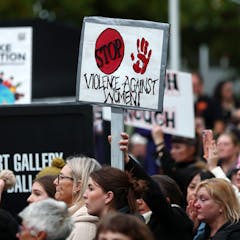
Articles on Domestic abuse
Displaying 1 - 20 of 123 articles

Evidence suggests that some individuals who hurt animals likewise act violently toward women and girls. Exploring that overlap can help prevent gender-based violence and animal abuse.

This is not the first time domestic violence has been declared a national crisis. Australian governments first got seriously involved in 1985. What can the past 40 years teach us?

Women are overwhelmingly the victims of sexualised violence, and men are commonly the perpetrators.

Public focus on, and anger about, the horrifyingly high rates of violence against women is at fever pitch. What have the country’s leaders agreed to, and will it fix the problem?

The government will introduce legislation to ban deepfake pornography and devote $925.2 million over five years to establish permanently a program with those eligible able to receive up to $5000.

In the rest of the UK, a person who causes the loss of pregnancy can be charged with ‘child destruction’.

It has been a distressing time. Australians have been – and will continue – taking action to end gender-based violence. So, are we making any progress? Here’s what the data show.

Restrictions on media coverage and the use of sexual history in court would be more effective changes.

Corrosive substance violence is horrific in any case, but the role of gender is often forgotten.

Being given information about the violent past of a current partner can be life changing. Police forces need better resources to be able to process requests.

The concept of “coercive control” reframes domestic violence as an attack on human rights and resources rather than an assault.

I’ve been writing on representations of domestic abuse since the noughties. It has been gratifying to see the increase in fictional depictions of this theme in the 21st century.

Childhood adversity can put people at risk of perpetrating domestic violence in the future. Having a supportive social network and learning ways to regulate the stress response, however, can help.

The lockdown gave some men a chance to increase their control and coercion of women.

Government departments, civil society groups and the private sector should pool resources and work together in a co-ordinated manner to prevent violent crime.

Mobile phones have extended the reach and control of abusive partners.

The support of friends and family can be crucial for domestic abuse victims.

New memoirs by Rachel Louise Snyder and Steph Lentz chart the territory of being shaped by an ill-fitting version of strict Christianity – and their struggle to free themselves.

New research linking police and healthcare data shows that victims of domestic abuse are detectable before the involvement of the police.

Two of Australia’s major banks have announced they will take action against financial abusers, including closing their accounts.





